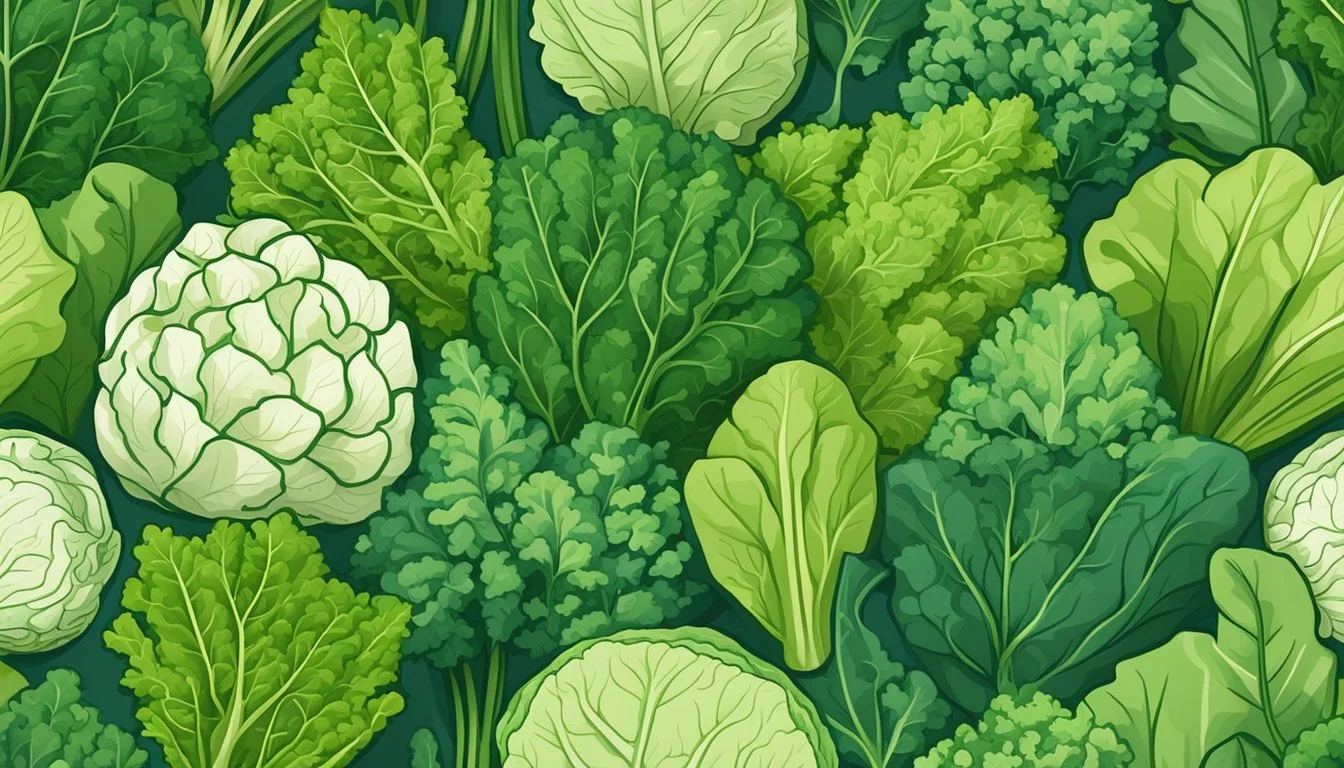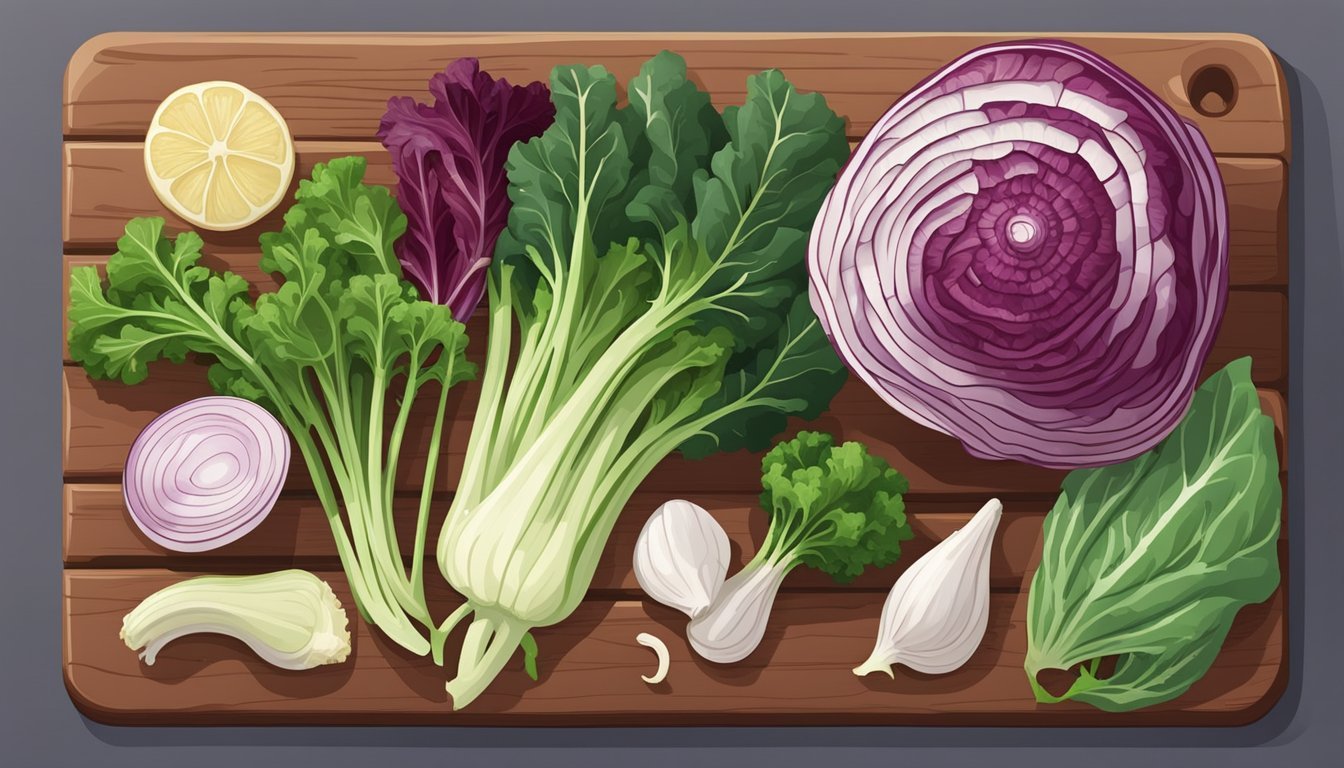Endive Substitutes
Top Alternatives for Salads and Recipes
Many chefs and home cooks love endive for its crisp texture and slightly bitter flavor, which adds depth to salads and various dishes. When you're out of endive, great substitutes include radicchio, arugula, watercress, chicory leaves, napa cabbage, and romaine lettuce. These alternatives offer similar textures and flavors, ensuring your recipes stay delicious.
For those crafting a hearty salad or looking to maintain that perfect balance of bitterness and crunch, chicory leaves and radicchio are excellent choices. Each of these leafy greens brings its unique flair, seamlessly fitting into dishes that call for endive.
Watercress and arugula, with their peppery undertones, satisfy the need for a flavor punch and crisp texture. Napa cabbage and romaine lettuce, on the other hand, provide a milder taste while still adding the needed crunch. Make sure to select the right substitute based on the specific requirements of your dish.
Understanding Endive
Endive is a versatile leafy vegetable known for its bitter flavor and is part of the chicory family. Known for its use in salads and various cooked dishes, it comes in different types and offers a rich nutritional profile.
Types of Endive
Endive comes in two main varieties: curly endive (also known as frisée) and Belgian endive (witloof chicory). Curly endive has frilly, bright green leaves with a sharp bitterness, making it popular in mixed salads for an added zing. In contrast, Belgian endive features pale, tightly packed leaves with a milder, slightly sweet flavor. Both types are valued for their unique, bitter taste and crunchy texture, essential characteristics for many dishes.
Culinary Uses
In the kitchen, endive is quite adaptable. Raw endive is often included in salads, lending a crisp texture and bitter undertone. Its leaves can also be used as edible scoops for appetizers. When cooked, such as grilled or braised, endive's bitterness mellows, allowing its sweet notes to shine. It pairs well with robust ingredients like blue cheese, nuts, and citrus. Endive can also be used in soups, stews, and casseroles.
Nutritional Profile
Endive is not only flavorful but also nutrient-dense. It is low in calories and provides a good source of dietary fiber. Additionally, endive contains essential vitamins such as Vitamin A, Vitamin C, and several B vitamins. Minerals like potassium, calcium, and iron are also present. Its high antioxidant content supports overall health, making it a beneficial addition to a balanced diet. The leafy greens offer various health benefits while complementing both raw and cooked dishes.
Fundamentals of Substituting Endive
When substituting endive, it is essential to consider both the flavor profile and the texture of the alternative vegetable. Proper substitution ratios also ensure that the dish retains its intended taste and consistency.
Flavor Matching
Endive has a distinct, slightly bitter taste which is important to duplicate in substitutes. Radicchio and chicory leaves are excellent choices because they offer similar bitterness. Arugula can also be used for its peppery undertone, though it is less bitter. Watercress provides a subtle sharpness that can mimic endive's palate. Each of these substitutes brings its unique nuance, so make a thoughtful selection based on the specific dish.
Texture Considerations
Texture plays a crucial role in replacing endive. Belgian endive has a crisp and firm texture. Radicchio and romaine lettuce offer crunchiness and can hold up well in salads. Napa cabbage is another sturdy option with a mild crunch. For cooked dishes, kale and collard greens provide robustness without wilting quickly. Ensure the texture of the substitute complements the other ingredients to maintain the dish's integrity.
Substitute Ratios
Using the correct substitution ratio is key. When using radicchio or chicory leaves, a 1:1 ratio effectively replicates the taste and texture of endive. For arugula, consider using slightly more, about 1.25:1, to balance its milder bitterness. With romaine lettuce or napa cabbage, maintaining a 1:1 ratio works well for raw uses. Adjusting ratios accurately ensures the desired outcome in both flavor and texture.
Raw Endive Alternatives
When looking for raw substitutes for endive, several vegetables can provide similar textures and flavors. These alternatives are often best used in salads and cold dishes, where their freshness can shine.
For Salads and Cold Dishes
Radicchio: This leafy vegetable offers a bright red color and a crisp texture, making it a vibrant addition to any salad. Its slightly bitter flavor pairs well with sweet or tangy dressings.
Arugula: Known for its peppery taste, arugula can add a unique kick to salads. Its tender leaves are best used fresh and can be combined with milder greens for balance.
Watercress: With a mild, slightly peppery flavor, watercress can be used in a 1:1 ratio as a direct substitute for endive. It works well in cold dishes and sandwich fillings.
Chicory Leaves: Often considered a close relative to endive, chicory leaves have a similar texture and slightly milder flavor. They provide a crunchy bite that complements various salad ingredients.
Romaine Lettuce: This common salad green is a practical choice for replacing endive. Its crisp and slightly sweet leaves make it versatile for many cold dishes.
Napa Cabbage: Although not a lettuce, napa cabbage offers a mild sweetness and crunchy texture. It can be thinly sliced and added to salads for a refreshing alternative.
Cooked Endive Substitutes
Cooking endive brings out a sweeter, more complex flavor, but substitutes such as escarole and radicchio can also deliver similar results. These alternatives work well in warm dishes like soups, stews, and gratins, maintaining the desired texture.
Best Options for Warm Dishes
Escarole is highly recommended for stews and soups. When cooked, it retains a slight bitterness and becomes tender, pairing well with ingredients like mushrooms and onions.
Radicchio is another excellent choice, especially for roasting or grilling. Radicchio's flavor mellows when cooked, adding a subtle sweetness to dishes, making it ideal for mixed warm salads or as a side for grilled meats.
Chicory Leaves, being close relatives of endive, also work well. Their slightly bitter taste complements roasted vegetables and hearty stews. Cooking chicory can boost your intake of vitamins A and C.
Maintaining Texture in Cooking
When substituting endive, maintaining texture is crucial for the dish's success.
Escarole can be sautéed lightly to keep its slight crunch while adding depth to cooked dishes.
Radicchio should be roasted or grilled until slightly charred, which softens its texture and enhances its flavors.
For stews and soups, chicory leaves hold up well, offering a bit of resistance and character, similar to how endive would behave in such preparations.
Keep an eye on cooking times to avoid over-softening these substitutes, as they should maintain some of their unique textures to provide the best results in warm dishes.
Alternative Leafy Greens
When looking for substitutes for endive, it's important to find leafy greens that can provide similar textures and nutritional benefits.
For Crunchy Textures
Certain leafy greens can replicate the satisfying crunch of endive. These options are ideal for salads or dishes where added texture is desired.
Radicchio has a firm, crunchy texture and a mildly bitter flavor. Its bright red color also adds visual appeal to dishes.
Romaine Lettuce offers a crisp bite and a milder taste, making it versatile enough for various recipes.
Iceberg Lettuce is a classic choice for crunch, though it lacks the bitterness of endive, its texture works well in most salads.
Napa Cabbage provides a unique combination of crunch and mildness, great for adding texture without overpowering other flavors.
Nutrient-Dense Varieties
For those prioritizing nutrition, several leafy greens can stand in for endive while boosting the nutrient profile of your meals.
Kale is rich in vitamins A, C, and K, as well as fiber and antioxidants. It can be used raw in salads or cooked in various dishes.
Spinach provides a wealth of nutrients, including iron, calcium, and magnesium. It’s versatile, suitable for salads, soups, or sautés.
Arugula offers a peppery flavor and is high in vitamins K and A. It can add a sharp, zesty note to dishes.
Escarole is a good source of folate and fiber. Its slightly bitter taste makes it a suitable substitute for endive in many recipes.
Frisée is similar to endive in taste and texture and is often used in salads to provide a slight bitterness and a lot of texture.
These alternatives can help you maintain the desired taste and health benefits in your cooking.
Health Considerations
Endive offers numerous health benefits due to its rich nutritional profile. High in fiber, it supports digestive health and aids in preventing constipation.
Endive is a good source of vitamins. It contains vitamins A, C, and K, all essential for maintaining overall health.
Minerals found in endive include iron, calcium, and magnesium. These minerals support various bodily functions such as bone health and oxygen transport.
Antioxidants present in endive help protect the body against oxidative stress. They play a role in reducing the risk of chronic diseases.
People looking to include endive substitutes should consider the nutritional content of alternatives like radicchio, arugula, and watercress. Each of these substitutes also contains varying amounts of vitamins and minerals beneficial for health.
Integrating Substitutes into Recipes
Replacing endive in recipes involves choosing alternatives that maintain desired flavor and texture. Important aspects to consider include adapting measurements and balancing the unique tastes of each substitute.
Recipe Adaptations
When swapping endive with another vegetable, adjust quantities based on the characteristics of the substitute. For example, radicchio and chicory leaves have a similar bitter profile, making them ideal for salads. Use the same amount as you would with endive for a direct replacement.
Watercress can replace endive in sandwiches or egg dishes, bringing a peppery crunch. If using napa cabbage, consider its milder taste and softer texture. Increase the amount slightly to enhance the dish’s body.
For cooked recipes, spinach and collard greens can be used. Cook these substitutes briefly, since they wilt quickly.
Balancing Flavors
Maintaining balanced flavors is essential when substituting endive. Arugula adds a peppery note, so combine it with milder ingredients like romaine lettuce to avoid overpowering the dish.
For a sweeter flavor, napa cabbage or escarole can be used. Adjust seasoning as needed to complement these vegetables.
Kale offers a robust texture but may need additional seasoning to replace the bitterness of endive. Use lemon juice or vinaigrettes to enhance the flavor.
When using collard greens, consider their slightly earthy taste. Pair them with tangy or spicy dressings to maintain a harmonious ensemble.





